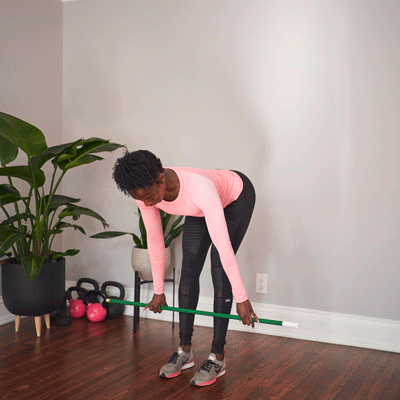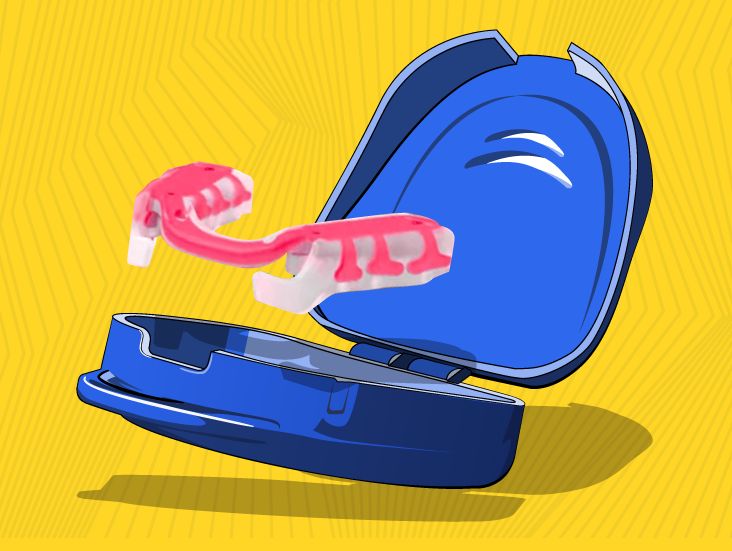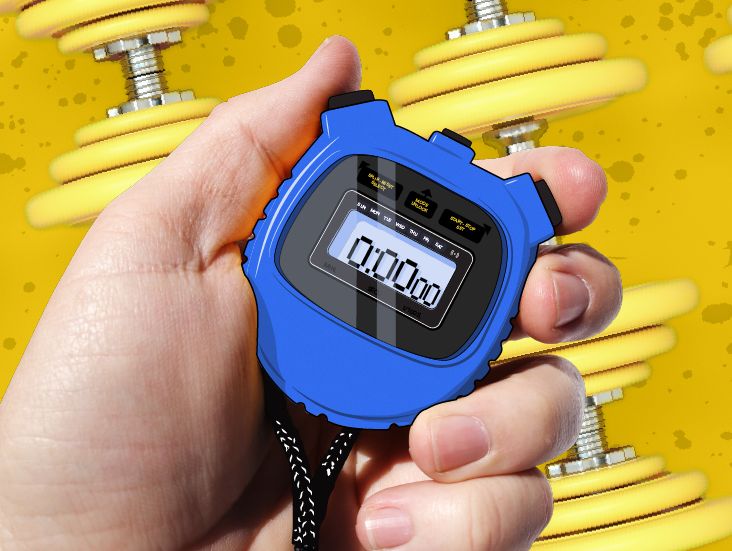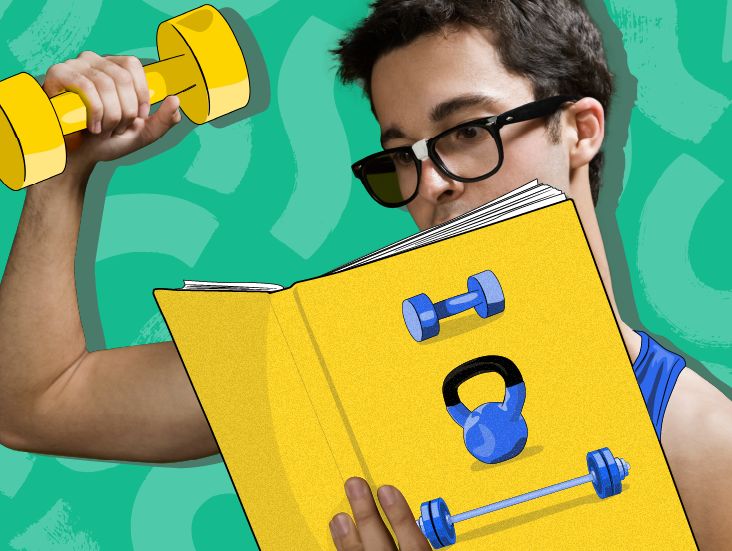If you’re looking to bulk up your biceps, chisel your chesticles, or hulk your hammies, you can’t go wrong with a good barbell exercise.
“The barbell is one of the best tools you can use to get stronger,” says Grayson Wickham, DPT, a physical therapist and the founder of Movement Vault, a digital movement education platform.
Primarily used for bilateral movements (those that use both arms and/or legs at the same time), a barbell allows you to lift heavier amounts than equipment primarily used for unilateral movements (those that use one limb at a time), like dumbbells, he says.
“And the more you lift, the more breakdown you cause in the muscles, which means the more muscle you’re able to put on with proper recovery.”
But what are the best barbell moves for building strength? We’re glad you asked.
Below, Wickham shares the five best barbell exercises for packing on muscle-meat.
Dubbed the “healthlift” by CrossFitters, the deadlift works more muscle groups to a greater degree than any other exercise, period, according to Wickham.
The deadlift primarily works your core and the muscles in your posterior chain, like your glutes, hamstrings, calves, lats, and rear shoulder muscles. “The muscles in the posterior chain are the most powerful muscles in your body,” he says. “If you want to be strong, a strong posterior chain is a MUST.”
Further, due to the movement pattern of the deadline (the hinge), most people are physiologically capable of moving more weight when deadlifting than with any other movement (including the squat!), he says.
And the more weight you lift, the stronger you get. In short, the deadlift gets you the biggest bang for your barbell buck.
Deadlift vs. sumo deadlift
A popular variation on the deadlift, the sumo deadlift involves positioning your feet outside your hips.
“Because your feet are wider and torso is more upright, the sumo deadlift works your quads to a greater degree and hamstrings to a lesser degree than the standard deadlift,” says Wickham.
Because there are huge health perks to strong hamstrings, he adds that if you’re going to do only one deadlift variation, it should be the standard.
How to do a barbell deadlift
- Stand with feet at hip width and the bar on the floor in front of you.
- Hinge at your hips and grip the bar on the floor with hands shoulder-width apart.
- Brace your midsection. Keeping back flat and neck neutral, use your hamstrings and glutes to pull the bar up along your legs.
- Squeeze your glutes at the top. Slowly return the bar to the floor.
Like the unweighted squat, the barbell back squat works your quads, hamstrings, glutes, and core. And because you’re stabilizing a weighted bar along your mid-to-upper back, it also works your back, shoulder, and trap muscles.
Front squat vs. back squat
Ultimately, the barbell squat variation that’s best for you will depend on your goals. Due to the placement of the bar, Wickham says that generally speaking, people can lift more weight while back squatting than front squatting. So if your goal is superhuman strength, the back squat is your better bet.
(If, however, you’re working on quad strength, clean position, or ankle mobility, the front squat would be the better choice, he notes.)
How to do a barbell back squat
- Rest the barbell behind your head, along your traps. Position your hands just outside your shoulders, making a W shape with your arms.
- With feet at hip width, brace midline and sit your butt back as if sitting on a chair.
- Lower as far as you can with good form. Then, press through your midfoot to drive hips forward and return to standing. Squeeze your glutes at the top.
“Sit ass-to-grass” may be a common refrain, but Wickham says most exercisers actually don’t have the necessary ankle or hip mobility to do so safely.
“Only go as far as you can go before you see your back start to round or knees start to cave forward,” he says. “Those are both indicators that you don’t currently have the mobility to go lower.”
An exercise that works your pecs, delts, and triceps, according to Wickham, the bench press is for ALL genders with varying fitness and strength levels.
The caveat: This move isn’t a good idea for anyone who experiences pain while benching or whose doctor or physical therapist has recommended against the exercise.
Flat vs. incline vs. decline
All three bench press variations work the same muscles. The difference?
“The incline is going to work the upper pec muscles to a greater degree, while the decline is going to put a little more emphasis on the lower pec muscles,” says Wickham.
How to do a barbell bench press
- Lie on the bench so your head and neck are supported. Gently rest the barbell across your sternum.
- Plant feet on either side of the bench and brace midsection for stability.
- Push (press) the barbell directly over your chest with both hands, fully extending arms.
- Lower the bar back down toward your chest, keeping elbows tucked toward rib cage as you do.
One of the main things to focus on while you press is bar path. The bar should N-O-T be making an S, C, or U shape in the air. Instead, it should be going straight up and down like a capital I.
Too much movement beyond that puts undue pressure on your shoulder joints and, over time, could lead to an overuse injury.
The strict press works many of the same pushing muscles as the bench press (deltoids, triceps, traps), but it works them through a different range of motion.
“Strengthening your shoulders through this range of motion supports you through life chores, which require that you go overhead,” says Wickham. Think putting the cereal away on the top pantry shelf or grabbing a new pack of toilet paper from the linen closet.
Strict press vs. push press vs. push jerk
The push press and push jerk are also pushing movements that strengthen your shoulders. But both are higher-skill movements that allow you to use your legs to propel the bar upward.
So, for people who don’t have access to a CrossFit or Olympic lifting coach or another fitness professional, Wickham says going with the strict press is best.
How to do a barbell strict press
- Put the bar in a front rack position: bar across chest, fingers outside shoulders, elbows facing out, and shoulders down. Make sure feet are stacked under hips.
- Keeping rib cage pulled down and core tight, press the bar straight overhead (be careful not to hit yourself in the chin as you do).
- Fully extend arms until the barbell is directly over your shoulder blades. Hold for 1 second before lowering the bar back down in the same path.
Now that we’ve covered the pushing movements, it’s time to talk about a pulling movement!
Behold the bent-over row.
“Pushing movement works the muscles on the front side of the body,” explains Wickham. If you’re only doing pushing movements and not pulling movements, it’s possible for those muscles to become overdeveloped and the muscles on the back side (lats and rhomboids) to become underdeveloped.
“Over time, that strength discrepancy can increase the risk of injury,” Wickham adds. Blergh! Luckily, you can reduce said risk by making sure you have an equal balance of pulling and pushing movements in your routine.
How to do a barbell bent-over row
- Grab a barbell with an overhand grip: palms facing toward you, hands shoulder-width apart.
- With feet at hip width and knees slightly bent, keeping arms straight and core tight, hinge forward until your upper body is nearly perpendicular to the floor.
- Grab the bar with both hands, shoot elbows straight up toward the ceiling, and pull the bar up to your chest.
- Pause at top before straightening your arms.
Worth mentioning: While you could load up the bar, Wickham says, “generally with the bent-over row you’re not going to go super heavy with it.” Most people are going to want to do sets somewhere in the 8-to-12-rep range.
While each of these moves can effectively build strength without adding weight, the amount of weight you use ultimately comes down to your fitness goals and comfort with the movement.
Assuming you can use any weight and maintain good form, allow your goals to dictate your weight, reps, and sets:
- To increase muscle size. Pick a weight you can lift for 3–4 sets of 8–12 reps.
- To increase muscle strength. Pick a weight you can lift for 4–6 sets of 2–5 reps.
- To increase muscle endurance. Pick a weight you can lift for 2–3 sets of 15–25 reps.
Building strength takes the right formula of grind, fuel, and rest. As Wickham puts it, “While lifting heavy is a big piece of the puzzle, to make the gains you’re looking for, you also need to dial in your sleep, nutrition, and stress levels.”







